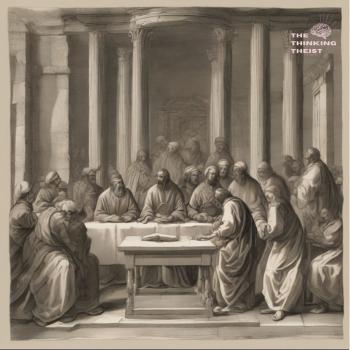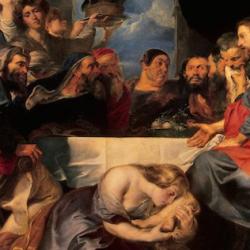Sermon outline for Feb 1:
The Days of the Son of Man, Luke 17:11-37
INTRODUCTION
Jesus’ mission was to proclaim “the kingdom of God” (Luke 4:43; 8:1). By this, He meant that God was taking control of the world through Him, and putting a sinful and shattered world back together. Through His preaching and healing, Jesus enacts this restoration. In Luke 17, He makes it clear that God’s power as king is already at work, and that it will come in even greater power.
THE TEXT
“Now it happened as He went to Jerusalem that He passed through the midst of Samaria and Galilee. Then as He entered a certain village, there met Him ten men who were lepers, who stood afar off . . . .” (Luke 17:11-37).
REBUKE AND FORGIVE
Central to the coming of the kingdom is the restoration of true friendship and community. Friendship or living in community does not mean tolerating everything everyone chooses to do. Nor can Pharisaism create true community. As Jesus shows in the parables in Luke 15-16, the Pharisees are too surly and too greedy to form genuine community.
To live as a true community, Jesus’ disciples must be looking out for one another, confessing sin to one another, rebuking one another, and continually forgiving one another. To live in true community, each believer must recognize that he is no more than a humble servant, who only does what is required of him (17:1-10).
WHERE ARE THE NINE?
Verse 11 marks a scene change, as Luke reminds us that Jesus has “set His face” to Jerusalem (9:51) and is traveling toward the city that kills prophets (13:34). Clearly, Luke’s account is not in chronological order, unless Jesus takes a crazy route to Jerusalem. Earlier in the journey, He was already in Bethany, a few miles from Jerusalem (10:38-42); here He is still in Samaria, in the territory north of Judea (17:11). Luke’s travel narrative is structured thematically and not chronologically.
As Jesus goes through a Samaritan village, ten lepers cry to Him (vv 12-13). Leprosy in the Bible is not the same as Hanson’s Disease. It is more like psoriasis; the skin dies and flakes away and the flesh beneath is exposed. Leprosy made the leper unclean, though it was not a life-threatening or transmittable disease (cf. Leviticus 13-14). Note that the lepers initially stand far off from Jesus and cry out to Him rather than draw near (v. 12). They keep aloof from Jesus for fear of spreading uncleanness. Jesus instructs them to show themselves to the priest, who would be able to examine them and pronounce them clean. Only one goes to the true Priest, Jesus, and approaches Him boldly, knowing that he has in fact been cleansed.
THE KINGDOM IS AMONG YOU
In the light of the miracle of cleansing the 10 lepers, the Pharisees’ question is ironic: Jesus has just demonstrated that the kingdom is present (cf. 7:18-23), and yet the Pharisees ask when the kingdom is going to come. Jesus says that they can’t recognize the kingdom by “close scrutiny of signs,” using the same word that Luke uses to describe the Pharisees’ monitoring of Jesus (cf. 6:7; 14:1). In their concentration on minutiae, the Pharisees have missed the forest for the trees: They keep “close scrutiny” on Jesus, but miss the most obvious fact about Him, namely, that He is the Expected One and that the kingdom has come through Him.
Jesus’ statement that the kingdom is “among you” has often been misunderstood. It is sometimes translated as “the kingdom of God is in you,” which implies that the kingdom is a hidden, private reality within a person’s heart. This doesn’t work in this context for two reasons: first, “you” is plural, which means that the kingdom is not something confined to an individual; second, and even more importantly, Jesus would hardly say that the kingdom of God is in the Pharisees. Jesus means instead that the kingdom of God, God’s rule and all the transforming changes that come with it, is already present, already in the midst of Israel, already there for the grasping.
THE DAYS OF THE SON OF MAN
The latter part of chapter 17 is sometimes taken as a prophecy of Jesus’ second coming at the end of the world. The New Testament does teach that Jesus will come again and the dead will be raised to judgment (1 Corinthians 15; Revelation 20), but that is not what Jesus is predicting here. He is telling His disciples (v. 22) how they should act when the great catastrophe falls on Israel and Jerusalem.
One of the emphases of the prophecy is the suddenness of Jesus’ coming. Just as people were quietly going about their business at the time of the flood and were suddenly swept away and just as the people of Sodom were living life without fear when fire and brimstone came from heaven, so it will be with Jerusalem (vv. 26-30). This is the meaning of the “one taken, the other left” sayings (vv. 34-36). Jesus is not saying that the rapture will take away the believer and leave the unbeliever. He is saying that the one will be taken away to destruction and the other left behind, as in the time of the exile when Nebuchadnezzar “took one” and “left another.” According to Jesus, you want to be “left behind.”
Because of the suddenness of the judgment, there will be no time to save one’s possessions. Like the stewardess on the airplane, Jesus says “In case of a crash landing, don’t try to take your luggage with you.” Lot’s wife turned around, longing for her old life in Sodom, and was turned to salt, dying along with the people of Sodom (v. 32). If anyone tries to preserve his goods and his old life, he will lose everything, including his life; only those willing to leave everything behind will survive in order to rebuild their lives (v. 33). No wonder Jesus has been warning that his disciples should not be attached to their possessions: When a flood starts or when fire comes from heaven, being an idolater of Mammon will be deadly.
How can Jesus call this great catastrophe the “days of the Son of Man” (vv. 22, 24)? The phrase “Son of Man” is taken from Daniel 7, where Daniel sees a vision of “one like a son of man” receiving dominion and power and the glory of all the kingdoms of the earth. The “Son of Man” in Daniel 7 is the Last Adam, the Son of Adam, who will overthrow and tame the beasts of ancient empire and will take their power from them. Jesus calls Himself “Son of Man,” which means that He expects to be given all authority and power. Jerusalem will reject the Son of Man (v. 25), and when the city is demolished it will be testimony to Jesus’ exaltation and authority. Plus, the test of a true prophet in Scripture is whether or not their predictions come true. Jesus predicted the fall of Jerusalem; it happened; and the event proved that Jesus was a true prophet. When Jerusalem fell, Jesus the Son of Man was proven to be Lord, Christ, and the final Prophet of God.
CATECHISM FOR LITTLE SAINTS
What should you do if your brother sins against you?
You should tell him he has sinned.
What should you do if your brother asks for forgiveness?
You should forgive him.
What if he asks again and again?
You should forgive him again and again.
FOR FURTHER STUDY
1. Describing the flood and the judgment on Sodom, Jesus lists several things that the people were doing prior to the catastrophe (vv. 27-30). How many things are listed in each case? Why?
2. Peter, like Jesus, links the flood with the judgment on Sodom (2 Peter 2). Read the accounts in Genesis 6-9 and 18-19. How were these judgments similar? How were they different? Why do Jesus and Peter link the two in predicting a future judgment?
3. The word for lightning “flashing” in 17:24 is also used in Luke 24:4. What is the connection?















